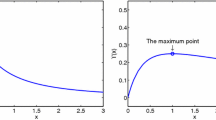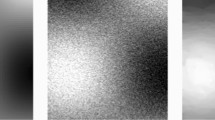Abstract
High-order variational models have the ability to remove the staircase effect generated by the total variation regularizer. They, however, tend to blur object edges. To overcome this drawback, we introduce an edge coherence-weighted second-order (ECSO) model for image denoising. We propose novel regularizers that use the edge coherence quantity to adjust the strength of regularization according to the characteristics of each pixel. We then adapt the split Bregman algorithm to solve the proposed model. All the subproblems are solved efficiently using the fast Fourier transform and the shrinkage operator. Extensive experiments show that the proposed model outperforms state-of-the-art high-order variational models for image denoising.








Similar content being viewed by others
References
Goyal, B., et al.: Image denoising review: From classical to state-of-the-art approaches. Inf. Fusion. 55, 220–244 (2020)
Rudin, L., et al.: Nonlinear total variation based noise removal algorithms. Phys. D 60(1–4), 259–268 (1992)
Papafitsoros, K., Schönlieb, C.: A combined first and second order variational approach for image reconstruction. J. Math. Imaging Vis. 48(2), 308–338 (2014)
Duan, J., et al.: An edge-weighted second order variational model for image decomposition. Digit. Signal Process. 49, 162–181 (2016)
Xu, X., et al.: Variational total curvature model for multiplicative noise removal. IET Comput. Vis. 12(4), 542–552 (2018)
Zhai, Y., et al.: Two variational models for image denoising using Jacobian of Normals. IEEE Access. 9, 43301–43315 (2021)
Chambolle, A., Lions, P.: Image recovery via total variation minimization and related problems. Numer. Math. 76(2), 167–188 (1997)
Hsieh, P., et al.: A regularization model with adaptive diffusivity for variational image denoising. Signal Process. 149, 214–228 (2018)
Phan, K., Tran, Y.: A space-variant nonlinear algorithm for denoising omnidirectional images corrupted by Poisson noise. IEEE Signal Process. Lett. 27, 535–539 (2020)
Belyaev, A., Fayolle, P.: Adaptive curvature-guided image filtering for structure+ texture image decomposition. IEEE Trans. Image Process. 27(10), 5192–5203 (2018)
Phan, K.: A weighted total variation based image denoising model using mean curvature. Optik 217, 164940 (2020)
Li, M., Li, B.: A novel weighted anisotropic total variational model for image applications. Signal Image Video Process. 16, 211–218 (2021)
Thanh, D., et al.: An adaptive method for image restoration based on high-order total variation and inverse gradient. SIViP 14(6), 1189–1197 (2020)
Xu, J., et al.: A novel variational model for image decomposition. SIViP 13(5), 967–974 (2019)
Pham, C.T., et al.: An adaptive algorithm for restoring image corrupted by mixed noise. Cybern. Phys. 8(2), 73–82 (2019)
Harris, C., Stephens, M.: A combined corner and edge detector. Alvey Vis. Conf. 15(50), 147–152 (1988)
Goldstein, T., Osher, S.: The split Bregman method for L1-regularized problems. SIAM J. Imag. Sci. 2(2), 323–343 (2009)
Roth, S., Black, M.J.: Fields of experts: a framework for learning image priors. Proc. IEEE Comput. Soc. Conf. Comput. Vis. Pattern Recogn. 2, 860–867 (2005)
Lebrun, M., et al.: The noise clinic: a blind image denoising algorithm. Image Process. Line 5, 1–54 (2015)
Setiadi, D.I.M.: PSNR vs SSIM: imperceptibility quality assessment for image steganography. Multimed. Tools Appl. 80, 8423–8444 (2021)
Getreuer, P.: Rudin–Osher–Fatemi total variation denoising using split Bregman. Image Process. Line 2, 74–95 (2012)
Author information
Authors and Affiliations
Corresponding author
Ethics declarations
Conflict of interest
The authors declare that they have no conflicts of interest.
Additional information
Publisher's Note
Springer Nature remains neutral with regard to jurisdictional claims in published maps and institutional affiliations.
Rights and permissions
About this article
Cite this article
Phan, T.D.K., Tran, T.H.Y. Edge coherence-weighted second-order variational model for image denoising. SIViP 16, 2313–2320 (2022). https://doi.org/10.1007/s11760-022-02209-z
Received:
Revised:
Accepted:
Published:
Issue Date:
DOI: https://doi.org/10.1007/s11760-022-02209-z




